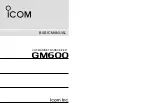
Outputs
DIQ/S 281
86
ba77244d01
08/2020
Pulse width output
The output of the pulse width is used, e.g. for controlling valves.
Pulse-width regulation changes the duration of operation (t
on
) of the output sig-
nal. Depending on the position of the measured value in the proportional range,
the relay is operated for a longer or shorter period.
If the measured value is at the end of the proportional range (
End value
), the
turn-on duration (t
on
) is long, the turn-off duration is short. This means the
relay operates for a longer period.
If the measured value is at the beginning of the proportional range (
Start
value
), the turn-on duration (t
on
) is short, and the relay operates for a corre-
spondingly shorter period.
Frequency output
Switching frequency output is used, e.g. for controlling dosing pumps.
In contrast to the pulse-width output, the pulse width is not modulated with the
frequency output but the switching frequency of the output signal. Depending on
the position of the measured value in the proportional range, the relay is
figure 6-4
Relay output of the pulse-width output
The cycle duration (T) is made up of the turn-on and turn-off switching
duration (t
on
, t
off
) of the relay together. While the selected cycle duration
(T) remains constant, the turn-on duration (t
on
) changes depending on
the measured value and, with it, the pulse width (v). The pulse width can
be set from 0 % to 100 %.
v = (t
on
/ T) * 100 %
v = pulse width, T = cycle duration, t
on
= turn-on duration
If the duration of the closing or opening pulse is shorter than 0.1 s,
the relay remains open or closed for the complete cycle duration.
T
Time [s]
Relay
Off
On
t
On
t
Off
Содержание WTW DIQ/S 281
Страница 2: ...DIQ S 28X 2 ba77244d01 08 2020 Copyright 2017 Xylem Analytics Germany GmbH Printed in Germany...
Страница 128: ...Messages DIQ S 281 128 ba77244e01 08 2020...
Страница 131: ......
















































